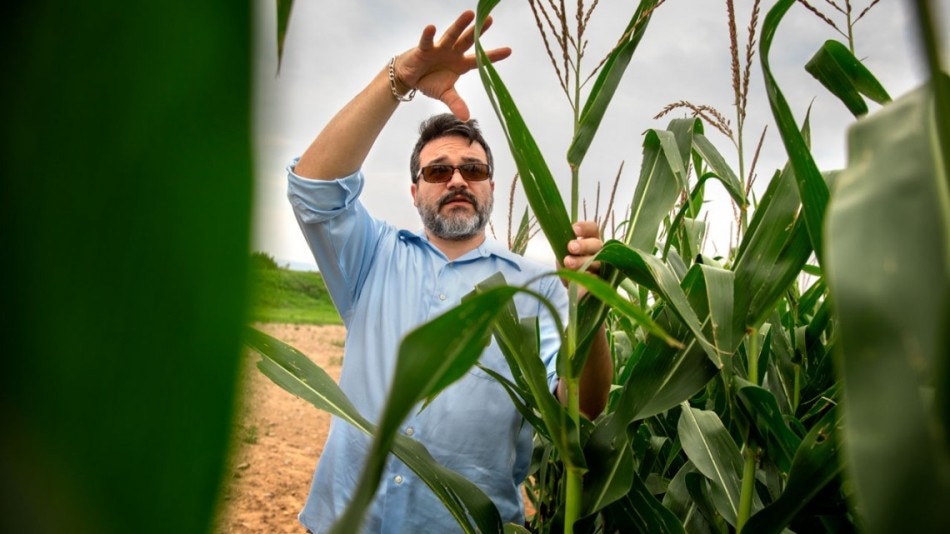Nov 2 2018
Mike Gore, PhD ’09, can hear the ticking of the clock. Though it isn’t an alarm clock, it’s part of what pushes him every day.
 Mike Gore, PhD ’09, plant geneticist in the College of Agriculture and Life Sciences, explains corn breeding at Musgrave Research Farm in Aurora, New York, in August. (Image credit: Lindsay France/Cornell Brand Communications)
Mike Gore, PhD ’09, plant geneticist in the College of Agriculture and Life Sciences, explains corn breeding at Musgrave Research Farm in Aurora, New York, in August. (Image credit: Lindsay France/Cornell Brand Communications)
Gore, associate professor of molecular breeding and genetics for nutritional quality, Liberty Hyde Bailey professor and international professor of plant breeding and genetics, conducts research at the intersection of more than a few disciplines. His lab uses genomics, analytical chemistry, quantitative genetics, and remote sensing to investigate the genetic basis of trait variation in crops such as oat, corn, and cassava.
For 10,000 years, plant breeding has been going on, he said, but technology—unmanned aerial vehicles (UAVs), artificial intelligence (AI), robots, and machine learning—is transforming the practice.
“One role that we plant breeders can play is to learn how to integrate these cutting-edge technologies into research programs,” he said, “so that we can more efficiently and effectively select [plant variations] for the high-yielding, or highly nutritious, cultivar that can help feed the world’s population.”
An enormous challenge for plant breeders as well as scientists in other disciplines is feeding the world’s population, he said. Cornell is looking at it with the Cornell Initiative for Digital Agriculture (CIDA), which is leveraging digital inventions in agriculture to enhance the sustainability, resiliency, profitability, and efficiency of the world’s food systems. Gore is in the CIDA leadership group.
Presently at about 7.6 billion people, Earth’s population is projected to touch around 10 billion by 2050. How will all those people be fed in an efficient and sustainable manner?
Gore confesses that, although there is still time to devise viable solutions, he is feeling the urgency.
“I think all plant scientists do,” Gore said. “We all share that passion, but we definitely hear that clock ticking. Let’s hope it’s not a timebomb.”
Gore’s lab uses “rapid phenotyping”—the ability to non-destructively measure a plant’s physiological, morphological, and biochemical properties in real time repetitively over the course of a growing season, instead of waiting until harvest. That could help minimize the time it takes to create crop varieties that are ideal for a specific climate or region.
“With these new technologies, we’re able to do phenotyping every day, every week, every month, to know how the plant is responding to the environment over whole growing seasons,” Gore said.
Among other crops, Gore’s lab concentrates on corn—including corn cultivated in upstate New York—and the development of variants that are ideally suited to the brief growing season and weather conditions. His lab utilizes camera-wielding UAVs—drones—and four-wheeled robots to carry out real-time diagnostics of numerous corn varieties at the Musgrave Research Farm in Aurora, New York, roughly 24 miles north of campus.
This past summer, his shared three-acre cornfield contained approximately 800 very diverse hybrids, each in two-row mini-plots, from which his team will try to identify the top varieties for cultivating in the upstate region.
Gore’s team—in partnership with the lab of Ed Buckler, adjunct professor of plant breeding and genetics—is building AI for the autonomous vehicles that can count individual plants, check individual leaves for disease, and measure plant height, among other tasks. This would enable him to run diagnostics on the plant at any point in its growth process.
“It’s like knowing a baseball player’s batting average in July, as opposed to just at the end of the season,” he said. “We’re trying to identify the key plant developmental stage that you can do the phenotyping on, so that it could be predictive of yield at the end of the season.”
“If you had that capability,” he said, “then you’d know what plants to cross-breed before the pollen’s even been shed.”
By employing technology to detect chief traits in midseason, Gore said, he could maybe formulate more precise breeding techniques—and cut the breeding timeline “from six to eight years, to maybe four or five” as the technologies are established.
He visualizes a day when a drone or robot can not only facilitate fast phenotyping but also detect weeds or fungal diseases and instantly dispense a herbicide or fungicide in a precise dose, at just the exact coordinate in the field. Although there will always be humans on a farm, Gore thinks a role-reversal could soon be an eventuality.
“If we can train the robots, perhaps someday the robots will be training us to do very precise plant breeding,” he said. “We have more than 800 highly diverse hybrids in this field [at Musgrave]. Which one is the best for growing here, and why? Those are the questions we’re trying to answer. … We’re trying to closely model the biological reality of a plant. I would argue that, over time, robots can probably do it even better than human beings. That’s what we’re kind of on the cusp of right now.”
Creating a corn variety that’s ideally suited for upstate New York is one of the numerous challenges Gore and scientists like him are attempting as the specter of feeding 10 billion people emerges.
“All of these tools are going to be important for food and nutrition security,” he said. “How do we figure out how to use these technologies for crops such as cassava, rice, maize, wheat that all of these developing nations are relying on for nourishment?”
“How do we turn the engine of evolution faster in plant breeding?” he asked. “We have to totally change the paradigm that we’ve been in for the past 10,000 years.”